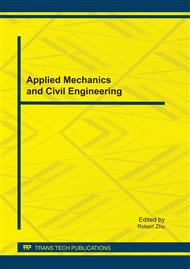[1]
Y.J. An, C.Y. Yang, Fridericia peregrinabunda (Enchytraeidae) as a new test species for soil toxicity assessment, J. Chemosphere. 77 (2009) 325-329.
DOI: 10.1016/j.chemosphere.2009.07.013
Google Scholar
[2]
J. Zhu, Y.T. Lu, Single and joint toxic effects of cadmium and phenanthrene on Enchytraediae Fridericia bulbosa, J. Eur. J. Soil Biol. 44(3) (2008) 260-265.
DOI: 10.1016/j.ejsobi.2008.03.002
Google Scholar
[3]
K. Lock, C.R. Janssen, Ecotoxicity of mercury to Eisenia fetida, Enchytraeus albidus and Folsomia candida, J. Biol. Fert. Soils. 34 (2001) 219-221.
DOI: 10.1007/s003740100392
Google Scholar
[4]
W.N. Beyer, E. Cromaritie, G.B. Moment Accumulation of methymercury in the earthworm, Eisenia fetida, and its effect on regeneration, J. B. Environ. Contam. Toxcol. 35 (1985) 157-162.
DOI: 10.1007/bf01636494
Google Scholar
[5]
E. Fischer, L. Koszorus, Sublethal effects, accumulation capacities and elimination rates of As, Hg and Se in the manure worm, Eisenia fetida, (Oligochaeta Lumbricidae), J. Pedobiologia. 36 (1992) 172-178.
Google Scholar
[6]
S. Sauve, M. Fournier, Age-specific immunocompetence of the earthworm Eisenia andrei: Exposure to methymercury chloride, J. Ecotoxicon. Environ. Saf. 60(2005)67–72.
DOI: 10.1016/j.ecoenv.2003.12.022
Google Scholar
[7]
S.N. Bagchi, T. Bitz, A Synechococcous elongatus PCC7942 mutant with a higher tolerance towards the herbicide bentazone also confers resistance to sodium chloride stress, J. Photosynth. Res. 92 (2007) 87–101.
DOI: 10.1007/s11120-007-9176-y
Google Scholar
[8]
C.L. Yang, T.H. Sun, Single and joint effects of pesticides and mercury on soil urease, J. J. Environ. Sci. 19 (2007) 210-216.
Google Scholar
[9]
M.E. Wang, Q.X. Zhou, Joint stress of chlorimuron-ethyl and cadmium on wheat Triticum aestivum at biochemical levels, J. Environ. Pollut. 144(2) (2006) 572-580.
DOI: 10.1016/j.envpol.2006.01.024
Google Scholar
[10]
Q.X. Zhou, M.E. Wang, J.D. Liang, Ecological detoxification of methamidophos by earthworms in phaeozem co-contaminated with acetochlor and copper, J. Appl. Soil Ecol.40 (1) (2008) 138-145.
DOI: 10.1016/j.apsoil.2008.03.014
Google Scholar
[11]
Baratac,J. Bardd, Toxicity of binary mixtures of metals and pyrethroid insecticides to Daphnia magna Straus. Implications for multisubstance riskes assessment, J. Aquat. Toxicol .78 (1) (2006) 1-14.
DOI: 10.1016/j.aquatox.2006.01.013
Google Scholar
[12]
Organization for Economic Co-operation and Development (OECD), OECD Guideline for Testing of Chemicals No 207, Earthworm Acute Toxicity Test. (1984)
Google Scholar
[13]
A.M. Bindesbol., B. Mark, Impacts of heavy metals, polyaromatic hydrocarbons,and pesticides onfreeze tolerance of the earthworm Dendrobaena octaedra, J. Environ. Toxicol. Chem. 28 (2009) 2341–2347.
DOI: 10.1897/09-078.1
Google Scholar
[14]
K.E. Giller, Toxicity of heavy metals to microorganisms and microbial processes in agricultural soils: a review, J. Soil boil. biochem. 30 (1998) 1389-1414.
DOI: 10.1016/s0038-0717(97)00270-8
Google Scholar
[15]
A.C. Belfroid, D.T. Sijm, Bioavailability and toxicokinetics of hydrophobic aromatic compounds in benthic and terrestrial invertebrates. Environ. Rev. 4 (1996) 276-299.
DOI: 10.1139/a96-015
Google Scholar


